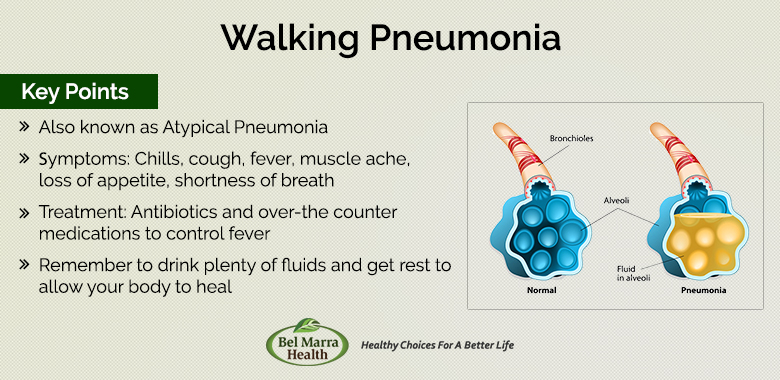 Walking pneumonia (atypical pneumonia) is a type of pneumonia, an illness that affects the upper and lower respiratory tract. The term walking pneumonia comes from the fact that many patients who have the condition don’t even realize it because their day-to-day living is not affected. Walking pneumonia does not involve hospitalization or bed rest as other types of pneumonia do, but still requires treatment to prevent complications.
Walking pneumonia (atypical pneumonia) is a type of pneumonia, an illness that affects the upper and lower respiratory tract. The term walking pneumonia comes from the fact that many patients who have the condition don’t even realize it because their day-to-day living is not affected. Walking pneumonia does not involve hospitalization or bed rest as other types of pneumonia do, but still requires treatment to prevent complications.
Types of walking pneumonia
There are three main types of walking pneumonia:
Advertisement
Mycoplasma pneumonia: A typically mild type caused by mycoplasma bacteria. Symptoms are similar to those of a cold or flu, and patients are rarely hospitalized with this type of pneumonia. In some cases, mycoplasma pneumonia can result in complications that require treatment.
Chlamydophilia pneumonia: Caused by chamydophilia bacteria, this type commonly affects school-aged children.
Legionella pneumonia: Caused by Legionella pneumophila bacteria, this type is not spread person to person, unlike other types of pneumonia. This is a more serious type of walking pneumonia, and can result in respiratory failure and death.
Walking pneumonia symptoms
 Symptoms of walking pneumonia are typically mild, hence, patients may not even realize they have pneumonia and may confuse it for a cold. Common symptoms of walking pneumonia include chills, cough, headache, fever, muscle aches, muscle stiffness, loss of appetite, shortness of breath, and rapid breathing.
Symptoms of walking pneumonia are typically mild, hence, patients may not even realize they have pneumonia and may confuse it for a cold. Common symptoms of walking pneumonia include chills, cough, headache, fever, muscle aches, muscle stiffness, loss of appetite, shortness of breath, and rapid breathing.
In mycoplasma pneumonia specifically, a rash may appear, while those with legionella pneumonia may also experience diarrhea and confusion.
Walking pneumonia causes
The underlying cause depends on the type of walking pneumonia you have, but walking pneumonia is generally caused by bacteria, virus, fungus, chemicals, inhaled food, and other infectious agents that enter the nose, throat, windpipe, or lungs. Specific bacteria that can cause walking pneumonia include mycoplasma, chlamydophilia, and legionella.
Walking pneumonia: Who is at risk? How common is atypical pneumonia?
Anyone can catch pneumonia, but certain groups may be at a higher risk to develop the respiratory condition than others. Walking pneumonia is commonly seen in older children and adults under 40. Individuals residing in crowded areas like schools, prisons, and shelters are at a higher risk of walking pneumonia. Smokers and those with chronic illness or a weakened immune system are also at a greater risk for contracting atypical pneumonia.
Walking pneumonia is fairly common, with nearly two million cases of walking pneumonia being mycoplasma pneumonia, accounting for one to 10 cases of 50 cases of community-acquired pneumonia. An estimated 8,000 to 18,000 patients are hospitalized for Legionnaires’ disease (legionella pneumonia) in the U.S each year.
Walking pneumonia diagnosis and treatment
 To diagnose walking pneumonia, your doctor will perform a physical exam and request a chest x-ray, a culture of mucus from your lungs, a sputum gram stain test, a throat swab, a complete blood count, as well as blood tests for antibodies and blood cultures.
To diagnose walking pneumonia, your doctor will perform a physical exam and request a chest x-ray, a culture of mucus from your lungs, a sputum gram stain test, a throat swab, a complete blood count, as well as blood tests for antibodies and blood cultures.
Advertisement
Walking pneumonia is commonly treated with antibiotics and over-the-counter medications to control fever. You shouldn’t take any cough medicine without your doctor’s okay as it can make it difficult to spit up mucus.
You should also drink plenty of fluids and get rest to allow your body to heal.
Preventing walking pneumonia
Some effective tips to lower your risk of walking pneumonia include exercising regularly, eating well-balanced meals, getting proper sleep and rest, washing hands frequently, abstaining from smoking as it damages your lungs, and covering your mouth and nose when you cough or sneeze. Also, read further on Is Pneumonia Contagious?

